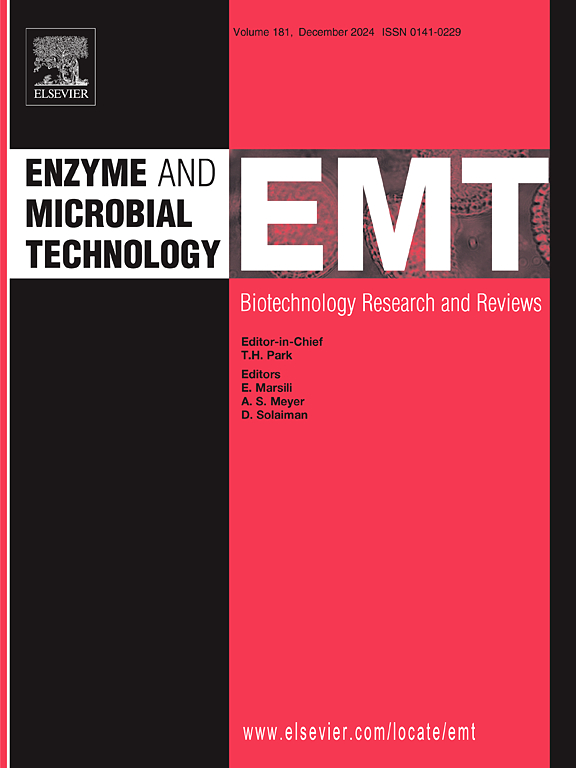Isolation, cloning, and characterization of a novel GH5 cellulase from yak rumen metagenome for enhanced lignocellulose hydrolysis in biofuel production and ruminant feed utilization
IF 3.7
3区 生物学
Q2 BIOTECHNOLOGY & APPLIED MICROBIOLOGY
引用次数: 0
Abstract
Lignocellulosic biomass is a promising feedstock for biofuel production, but its complex structure, including cellulose and hemicellulose, challenges efficient enzymatic hydrolysis. CelyA, a novel cellulase from the yak rumen, has potential for improving biomass degradation and biofuel production. The CelyA gene was cloned, expressed, and purified. Biochemical characterization included assessments of pH, temperature, and salt tolerance. The enzyme's substrate specificity was tested on crystalline cellulose, CMC, and other polysaccharides. In vitro rumen fermentation was performed to evaluate its effect on fiber digestibility and microbial community composition. Biofuel production was tested by hydrolyzing maize, rice, and wheat straw. CelyA demonstrated optimal activity at pH 6.0 and 40.0 °C and maintained moderate stability across a wide pH range (3.0–12.0), retaining measurable activity even under strongly acidic and alkaline conditions. The enzyme demonstrated excellent salt tolerance, retaining 91.0 % activity in 1.0 M NaCl. CelyA efficiently degraded maize straw in hydrolysis assays, producing 7.2 µmol/L of reducing sugars. In vitro rumen fermentation with CelyA increased fiber digestibility by 8.3 % for maize straw, 14.5 % for rice straw, and 2.7 % for wheat straw. Gas production also increased significantly, with maize straw showing a 91.3 % increase. 16S rRNA sequencing revealed selective enrichment of Ruminococcus and Prevotella, key cellulolytic microbes. CelyA demonstrates strong potential for biofuel production, efficiently hydrolyzing lignocellulosic biomass and enhancing ruminal fiber digestibility. Its stability, salt tolerance, and substrate specificity make it a valuable enzyme for biofuel production and livestock feed optimization.
牦牛瘤胃宏基因组中新型GH5纤维素酶的分离、克隆和特性分析,用于提高生物燃料生产和反刍动物饲料利用中的木质纤维素水解
木质纤维素生物质是一种很有前途的生物燃料原料,但其复杂的结构,包括纤维素和半纤维素,挑战了高效的酶解。CelyA是一种来自牦牛瘤胃的新型纤维素酶,具有改善生物质降解和生物燃料生产的潜力。对CelyA基因进行克隆、表达和纯化。生化表征包括pH值、温度和耐盐性的评估。该酶对结晶纤维素、CMC和其他多糖的底物特异性进行了测试。通过体外瘤胃发酵研究其对纤维消化率和微生物群落组成的影响。生物燃料的生产是通过水解玉米、水稻和麦秆来测试的。CelyA在pH 6.0和40.0°C时表现出最佳活性,并在较宽的pH范围(3.0-12.0)内保持适度的稳定性,即使在强酸性和碱性条件下也保持可测量的活性。该酶表现出优异的耐盐性,在1.0 M NaCl中保持91.0 %的活性。在水解实验中,CelyA能有效地降解玉米秸秆,产生7.2µmol/L的还原糖。在体外瘤胃发酵条件下,玉米秸秆、水稻秸秆和小麦秸秆的纤维消化率分别提高了8.3 %、14.5 %和2.7 %。产气量也显著增加,其中玉米秸秆增产91.3 %。16S rRNA测序结果显示,Ruminococcus和Prevotella选择性富集,这是关键的纤维素分解微生物。CelyA在生物燃料生产方面具有强大的潜力,可以有效地水解木质纤维素生物质并提高瘤胃纤维的消化率。它的稳定性、耐盐性和底物特异性使其成为生物燃料生产和牲畜饲料优化的重要酶。
本文章由计算机程序翻译,如有差异,请以英文原文为准。
求助全文
约1分钟内获得全文
求助全文
来源期刊

Enzyme and Microbial Technology
生物-生物工程与应用微生物
CiteScore
7.60
自引率
5.90%
发文量
142
审稿时长
38 days
期刊介绍:
Enzyme and Microbial Technology is an international, peer-reviewed journal publishing original research and reviews, of biotechnological significance and novelty, on basic and applied aspects of the science and technology of processes involving the use of enzymes, micro-organisms, animal cells and plant cells.
We especially encourage submissions on:
Biocatalysis and the use of Directed Evolution in Synthetic Biology and Biotechnology
Biotechnological Production of New Bioactive Molecules, Biomaterials, Biopharmaceuticals, and Biofuels
New Imaging Techniques and Biosensors, especially as applicable to Healthcare and Systems Biology
New Biotechnological Approaches in Genomics, Proteomics and Metabolomics
Metabolic Engineering, Biomolecular Engineering and Nanobiotechnology
Manuscripts which report isolation, purification, immobilization or utilization of organisms or enzymes which are already well-described in the literature are not suitable for publication in EMT, unless their primary purpose is to report significant new findings or approaches which are of broad biotechnological importance. Similarly, manuscripts which report optimization studies on well-established processes are inappropriate. EMT does not accept papers dealing with mathematical modeling unless they report significant, new experimental data.
 求助内容:
求助内容: 应助结果提醒方式:
应助结果提醒方式:


